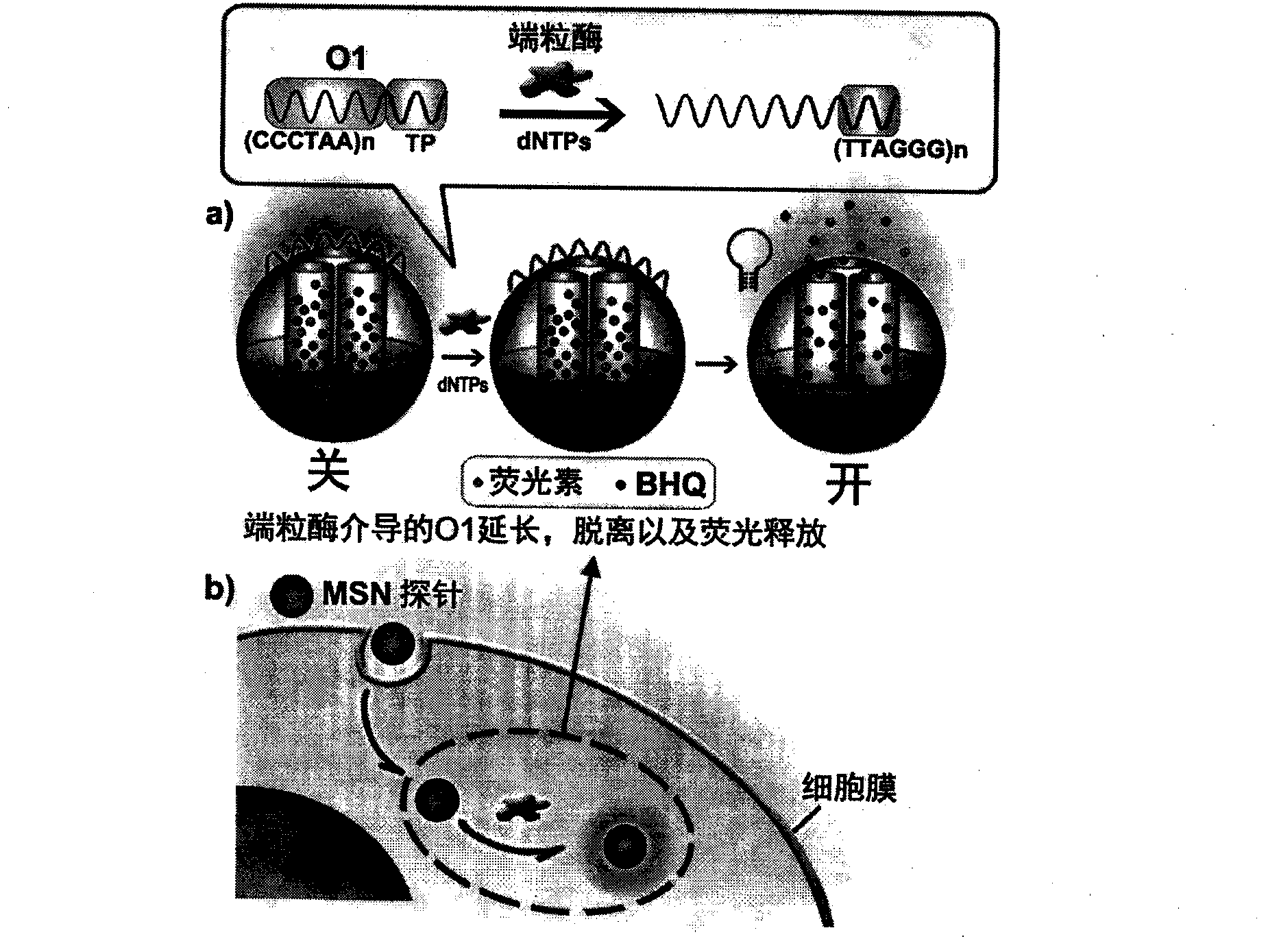Nanometer probe for detecting activity of intracellular telomerase in situ and preparation method thereof
A nano-probe, in-situ detection technology, applied in biochemical equipment and methods, measurement devices, microbial determination/inspection, etc. Effect
- Summary
- Abstract
- Description
- Claims
- Application Information
AI Technical Summary
Problems solved by technology
Method used
Image
Examples
Embodiment 1
[0018] Example 1: Combining figure 1 , Synthesis of nanoprobes for in situ detection of intracellular telomerase activity
[0019] Add 1 mg of carbodiimide (EDC), 2.5 mg of N-hydroxysuccinimide (NHS) and 0.1 mg of carboxyl BHQ to 1 mL of 1 mg / mL aminated MSN dispersion, and stir magnetically for 4 hours at room temperature. MSN-BHQ was obtained after centrifugation and washing. Disperse MSN-BHQ in 1 mL of water and add 0.1 mg of fluorescein, and keep stirring overnight at room temperature. Centrifuge and wash the precipitate with ultrapure water and dry to obtain fluorescein MSN-BHQ. Disperse 1 mg of fluorescein MSN-BHQ in 1 mL of hybridization buffer (containing 10 mM Tris hydrochloride, 1 mM EDTA, 50 mM NaCl and 10 mM MgCl 2 ), add 10 μL (100 μM) O1, continue stirring at 37° C. for 1 hour, and centrifuge to obtain the MSN probe. Probes were dispersed in 1mL HB and stored at 4°C.
Embodiment 2
[0020] Example 2: Combining figure 2 , In situ detection of intracellular telomerase activity using nanoprobes
[0021] Using HeLa cervical cancer cells as a model, HeLa cells (0.5 mL, 1×10 6 mL -1 ) were cultured in 20-mm confocal dishes at 37°C for 24 hours. Then, 15 μL of MSN probe (1 mg / mL) was added to the culture dish, incubated at 37° C. for 1.5 hours, and then detected with a laser confocal fluorescence microscope. In telomerase-positive HeLa cells, the pore channel of the MSN probe was opened to release fluorescein, and a fluorescent signal appeared in the cytoplasm, realizing in situ imaging of telomerase activity in the cell. Cells (0.5 mL, 1×10 6 mL -1 ) were co-cultured for 48 hours, then 15 μL of MSN probe (1 mg / mL) was added to the petri dish, and after incubation at 37° C. for 1.5 hours, the change of telomerase activity after drug action was observed under a confocal microscope.
PUM
 Login to View More
Login to View More Abstract
Description
Claims
Application Information
 Login to View More
Login to View More - R&D
- Intellectual Property
- Life Sciences
- Materials
- Tech Scout
- Unparalleled Data Quality
- Higher Quality Content
- 60% Fewer Hallucinations
Browse by: Latest US Patents, China's latest patents, Technical Efficacy Thesaurus, Application Domain, Technology Topic, Popular Technical Reports.
© 2025 PatSnap. All rights reserved.Legal|Privacy policy|Modern Slavery Act Transparency Statement|Sitemap|About US| Contact US: help@patsnap.com


